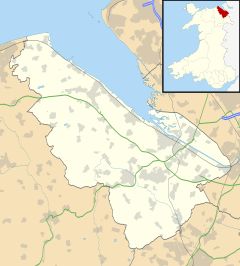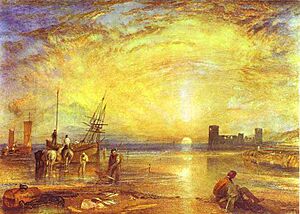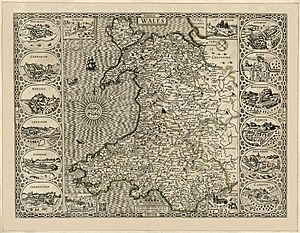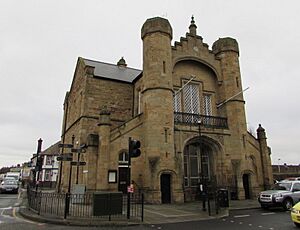Flint, Flintshire facts for kids
Quick facts for kids Flint
|
|
|---|---|
| Town and community | |
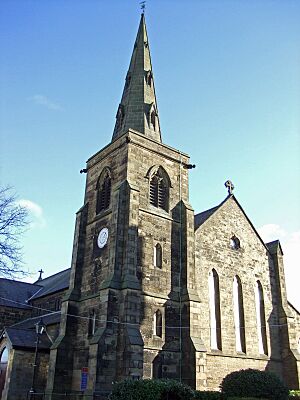 St Mary's Church, Church Street |
|
| Population | 13,736 (2021) |
| OS grid reference | SJ243729 |
| Community |
|
| Principal area | |
| Ceremonial county | |
| Country | Wales |
| Sovereign state | United Kingdom |
| Post town | FLINT |
| Postcode district | CH6 |
| Dialling code | 01352 |
| Police | North Wales |
| Fire | North Wales |
| Ambulance | Welsh |
| EU Parliament | Wales |
| UK Parliament |
|
| Welsh Assembly |
|
Flint (Welsh: Y Fflint) is a town and community in Flintshire, Wales. It sits on the estuary of the River Dee. Flint used to be the main town of Flintshire. In 2021, about 13,736 people lived in the Flint community.
Contents
Where is Flint Located?
Flint is in north-east Wales, right next to the River Dee estuary. It is north of the town of Mold. From Flint, you can see the Wirral across the estuary. To the south, you can see Halkyn Mountain. Flint is less than 12 miles from Liverpool, England, if you fly like a bird. However, because of two river estuaries in between, driving there takes almost twice as long.
A Look at Flint's History
The name "Flint" comes from the stony ground where the castle was built. It was first recorded in 1277.
Flint Castle and Edward I
King Edward I started building Flint Castle in 1277. This was during his efforts to take control of Wales. Both the castle and the town were attacked in 1294-95 by the forces of Madog ap Llywelyn. The town's defenders burned it down so the Welsh forces could not use it.
Important Moments at the Castle
In 1399, King Richard II was handed over to his enemy, Henry Bolingbroke, at Flint Castle. This event is even featured in Shakespeare's play, Richard II. Flint Castle was the first of Edward I's "iron ring" of castles built in Wales. Its design helped inspire larger castles like Harlech Castle and Rhuddlan Castle. In 1400, Owain Glyndŵr tried to attack it but failed.
Town Defenses and Growth
Flint town did not have a stone wall. Instead, it had a protective ditch with an earthen and wooden fence. You could see the outline of this until the mid-1960s. The old town boundary can still be traced today, as shown on John Speed's map of Flintshire.
The Flint Town Hall was built in 1840. It is where the Flint Town Council meets. Until 1935, the person in charge of Flint Castle was also automatically the Mayor of Flint.
National Eisteddfod Visits Flint
In 1969, Flint hosted the National Eisteddfod, a big Welsh festival of culture. Because of this, the town has a circle of Gorsedd stones near Gwynedd County Primary School. In 2006, these stones were used for the ceremony announcing Mold as the host town for 2007. The Urdd National Eisteddfod, a youth festival, was also held in Flint in 2016.
How Flint is Governed
Flint is managed by the Flint Town Council. This council has 15 councillors. They are chosen from four different areas called wards. For elections to Flintshire County Council, three councillors come from Flint. Flint is also part of the Alyn and Deeside area for the Senedd (Welsh Parliament) and the UK Parliament.
Culture and People in Flint
In 2011, over half of the people in Flint (57.1%) said they had Welsh identity. Many people in Flint know some Welsh language, though how well they speak it can vary.
Polish Influence
Because of rules allowing people to move freely within the European Union, more Polish-speaking people have moved to Flint. You can see information in Polish in some shops. There are also "Polskie sklepy" (Polish shops) that sell Polish products.
The Flint Accent
The way people speak in Flint is unique. It's a mix of Welsh speakers, early Irish settlers, and people from nearby Cheshire, Wirral, and Merseyside. Sometimes, people mistake the Flint accent for a Liverpool accent.
Songs About Flint
There are a few songs linked to Flint. "The Yard" is one of the most popular. Another well-known song is "Fifty German bombers over Flint." This song tells a funny story about a wartime bombing raid meant for Liverpool that accidentally hit Flint. It describes how the bombers were shot down by the "Bagillt Navy" and the German aircrew were rescued by the "Greenfield Fishers."
Getting Around Flint
Flint railway station is on the North Wales Coast Line. You can catch Transport for Wales trains from here to Manchester Piccadilly and Llandudno. There are also trains that go between Cardiff and Holyhead. Some Avanti West Coast trains from London Euston to Holyhead also stop here. Bus services in Flint are run by Arriva Buses Wales.
Schools in Flint
Flint has three high schools: St Richard Gwyn Catholic High School, Flint High School, and Ysgol Maes Hyfryd. There are also several primary schools: Gwynedd School, Cornist Park School, Ysgol Croes Atti (which teaches in Welsh), St Mary's Catholic Primary School, and Ysgol Pen Coch.
Flint's Community Life
Flint used to have its own small TV transmitter. This helped people get Welsh TV channels better. Since 2009, TV signals come from Storeton transmitting station on the Wirral.
Three tall apartment buildings are a striking sight near the town centre. The first two were built in the 1960s and named Bolingbroke Heights and Richard Heights. A third, Castle Heights, was added later.
Sports in Flint
Flint's football team is Flint Town United. They are nicknamed "the Silkmen." They play their home games at Cae-y-Castell. In the 2023/24 season, they were promoted to the Cymru Premier, which is the top football league in Wales.
Local Facilities
Flint has a library that was updated in 2020. There is also a leisure centre called the Jade Jones Pavilion. This centre is named after Jade Jones, an Olympic champion from Flint. As of February 2023[update], Flint Retail Park was getting bigger. The town centre has also been improved since 2012.
A lifeboat station was set up in Flint in 1966. It is run by the RNLI, which helps people at sea.
Famous People from Flint
- Paul Draper (born 1970), a songwriter and musician, went to school in Flint.
- Ian Puleston-Davies (born 1958), an actor and writer, known for playing Owen Armstrong in Coronation Street.
- Julie Roberts (born 1963), a painter.
Sports Stars from Flint
- Enoch Bagshaw (1884–1930), an American football player and coach.
- Ron Hewitt (1928–2001), a footballer who played over 500 club games and 5 for Wales.
- Allan Jones (1940–1993), a footballer with 249 games for Brentford F.C..
- Brian Godfrey (1940–2010), a footballer with over 590 club games and 3 for Wales.
- Andy Holden (born 1963), a footballer and nephew of Ron Hewitt.
- Jade Jones (born 1993), won Olympic gold medals in taekwondo in 2012 and 2016. She went to Flint High School.
- Ian Rush (born 1961), a famous footballer with 602 club games and 73 for Wales. He went to school in Flint.
- Dylan Levitt (born 2000), a footballer who plays for Hibernian F.C. in Scotland.
See also
 In Spanish: Flint (Flintshire) para niños
In Spanish: Flint (Flintshire) para niños


